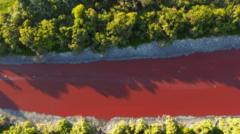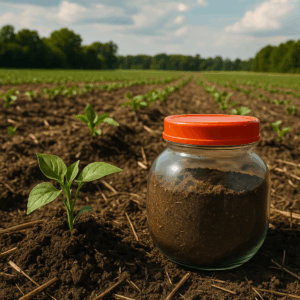The changing colors of the Sarandí canal raise significant concerns about environmental health and industrial waste management in Buenos Aires.
**Red Alert: Buenos Aires Canal Stains Waterway with Unusual Hue**

**Red Alert: Buenos Aires Canal Stains Waterway with Unusual Hue**
Bright red discoloration alarms residents as authorities investigate possible pollutants contributing to the shocking transformation of Sarandí canal.
A suburban canal in Buenos Aires shocked local residents when it transformed into a bright red hue on Thursday, raising alarms about potential environmental contamination. The striking images of the Sarandí canal, which flows into the Rio de la Plata and borders an ecological reserve, were shared widely on social media, prompting questions about what triggered such an unusual occurrence.
While local media speculate that the vibrant color may stem from the illegal dumping of textile dyes or chemical waste from nearby factories, the Argentine Environment Ministry has stepped in, announcing they have collected water samples for analysis to determine the exact cause.
By late Thursday afternoon, observers noted that the canal's color had faded somewhat, but this hasn't eased residents' worries. Longtime locals reported that, beyond the current red, the water has exhibited various shades—including yellow, green, and pink—over the years, often carrying a strong, unpleasant odor.
A local resident, Silvia, voiced her concerns on the news outlet C5N, stating, "Although it is red now, it has been yellow before, with an acidic smell that makes us sick even in the throat." Another resident, Maria Ducomls, described seeing grease on the surface of the water, indicating long-standing issues of industrial waste disposal in the area.
With the vicinity being home to various leather processing and textile factories, there is rising pressure on local industries to handle waste responsibly and prevent hazardous materials from contaminating water sources, which ultimately affects man and nature alike. The ongoing incident underlines the urgent need for rigorous environmental safeguards and corporate accountability in Argentina’s industrial sector.
While local media speculate that the vibrant color may stem from the illegal dumping of textile dyes or chemical waste from nearby factories, the Argentine Environment Ministry has stepped in, announcing they have collected water samples for analysis to determine the exact cause.
By late Thursday afternoon, observers noted that the canal's color had faded somewhat, but this hasn't eased residents' worries. Longtime locals reported that, beyond the current red, the water has exhibited various shades—including yellow, green, and pink—over the years, often carrying a strong, unpleasant odor.
A local resident, Silvia, voiced her concerns on the news outlet C5N, stating, "Although it is red now, it has been yellow before, with an acidic smell that makes us sick even in the throat." Another resident, Maria Ducomls, described seeing grease on the surface of the water, indicating long-standing issues of industrial waste disposal in the area.
With the vicinity being home to various leather processing and textile factories, there is rising pressure on local industries to handle waste responsibly and prevent hazardous materials from contaminating water sources, which ultimately affects man and nature alike. The ongoing incident underlines the urgent need for rigorous environmental safeguards and corporate accountability in Argentina’s industrial sector.























